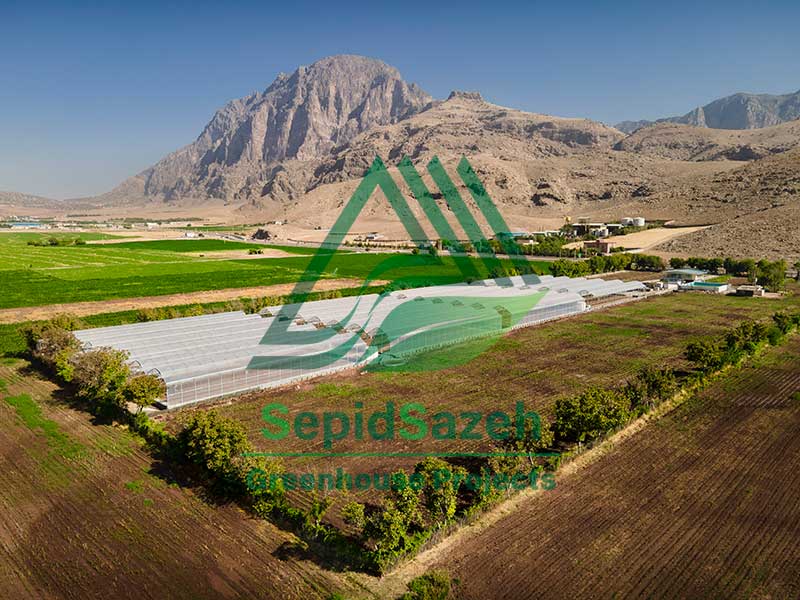Common greenhouses can be divided into the following types based on appearance:
1- Gable roof (A Frame)
2- Curved roof
4- Domed roof (Gothic arch)
5- Teeth (Sawtooth and Killion)
Curved roof
The main reason for using arched roofs is to get the maximum air inside the greenhouse with the least amount of coverage. Minimizing the surface of the greenhouse cover will bring benefits such as less consumption of the cover and also reducing the heat exchange of the greenhouse with the open space and thus reducing fuel consumption. In arch structures, plastic cover is easily used and fixed to the structure. The presence of an arch makes the cover work well in both wind and wind directions. Due to their aerodynamic appearance, tunnel structures show the least resistance against the wind.
The light weight of the cover and the natural resistance of these structures make the tunnel structure cheap and easy to install. The low thermal exchange of polyethylene covers as well as the special properties that are applicable in polyethylene covers (such as the return of infrared rays into the IR greenhouse and reducing energy consumption - distribution of a uniform light - anti-perspirant properties - insect control and subsequently reducing The use of pesticides in the greenhouse is another reason for its use in commercial greenhouses. Coordination with different climates and the possibility of its construction in large areas, as well as the mentioned advantages, have led to the widespread use and development of these greenhouses in the world.
Another capability of tunnel structures is to use the second cover and inject compressed air into it, which reduces 30% energy consumption in the greenhouse. This feature also helps to eliminate the problem of sweating in the lower wall of the greenhouse. It is possible to achieve this in glass greenhouses by using double or triple polycarbonate covers. The appearance of these single-tunnel greenhouse structures is similar to a semi-oval, so that there is the possibility of cultivation and traffic in the entire space inside the greenhouse. To make more use of the sides of the greenhouse, start the arch with vertical supports, which are known as the side wall model.
Two things can be mentioned as specific defects of these types of greenhouses: the surface of the greenhouse cover is horizontal at the highest point, and this leads to the lack of proper snow conduction and more importantly, humidity and perspiration stay at that point. This shortcoming can be solved by using the cover of the second wall as well as the construction of dome roof greenhouses. Of course, methods such as humidity control by increasing the temperature are also used to reduce the humidity inside the greenhouse.
The second problem of these types of greenhouses is ventilation. Building a window system for these types of greenhouses is more difficult than A Frame greenhouses. Considering that natural air ventilation is one of the most important items of commercial greenhouses to reduce the cost of temperature and humidity control, therefore, the correct and efficient implementation of this system is very important.
Methods such as using roof windows in different models are implemented in these types of greenhouses, ventilation with side windows (roll up) is also used for more efficiency in commercial greenhouses. Even some of the greenhouse manufacturing companies use the roll-up system (in which the cover is rolled up and down) in ceiling ventilation to reduce the cost of the structure. Building a window with a high level of ventilation and using it at the highest point of the structure is one of the advantages and parameters that the construction companies emphasize. It is also common to use this type of structure to protect against rain (Rain house) or shade house (Shade house). The high speed of installation of these structures makes it possible to use them for temporary protection.
Advantages:
- Cheapness and lightness of the structure (materials and coating)
- Maximum controllable air with minimum materials
- The possibility of using polyethylene covers with suitable growth properties
- Stability against wind and storm
- High speed in installation
- Usable and economical for any production
- Reducing fuel consumption
Disadvantages:
- The problem of increasing humidity
- Poor ventilation
Sawtooth and skillion
Saw tooth greenhouses are another idea to solve the defects of tunnel greenhouses. This greenhouse model is used for large areas. The slope of the greenhouse is such that in the summer the reflected light of the sun does not enter the greenhouse, and instead in the winter when the sunlight shines obliquely, it enters the greenhouse with the greatest reflection. This feature of sawtooth greenhouses makes it possible to use them for tropical regions. The existence of roof ventilation with a roll-up system, which is cheaper than a roof window with a rack and pinion system, is one of the advantages of this plan. The proper ventilation for these greenhouses is to place the vents facing the wind, in which case ventilation is done by air suction. The roof window system in sawtooth greenhouses can also be used as a sliding system.

